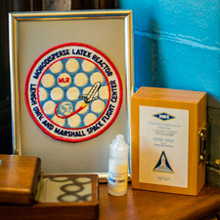The first commercial product manufactured in space—microscopic plastic beads—used a chemical engineering process designed by Lehigh researchers with NASA funding. The tiny beads were made in 1983 in near-weightless conditions aboard the maiden flight of the Space Shuttle Challenger.
Mohamed S. El-Aasser, professor of chemical engineering, and the late John W. Vanderhoff and Fortunato J. Micale, professors emeritus of chemistry, ran five experiments on the shuttle and were named NASA Inventors of the Year in 1984.
The researchers made 10- and later 30-micron particles of polystyrene. (About 18,000 10-micron particles reportedly could fit on the head of a pin.) On earth, the particles would have formed a sediment; in the microgravity of space they remained suspended throughout polymerization while maintaining their individuality. The 10-micron particles have been used for calibrating blood counters.
Since the Challenger experiments, engineers have used the Lehigh process to make polymer particles as large as 215 microns that are uniform in size.




